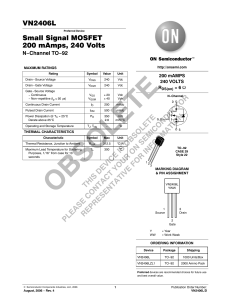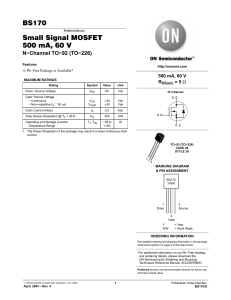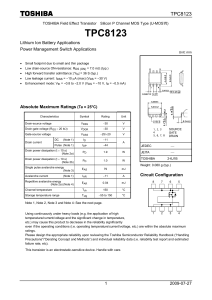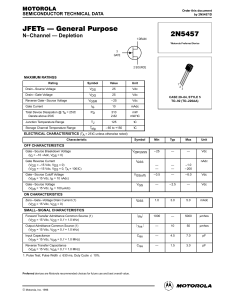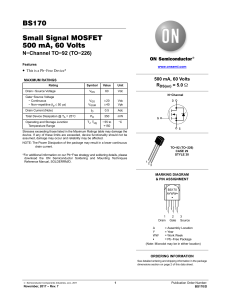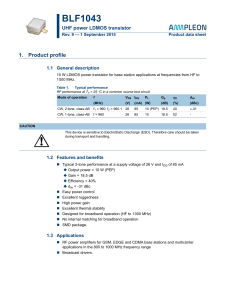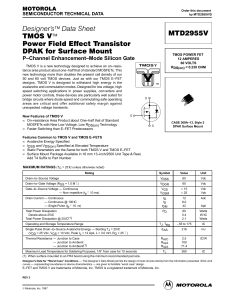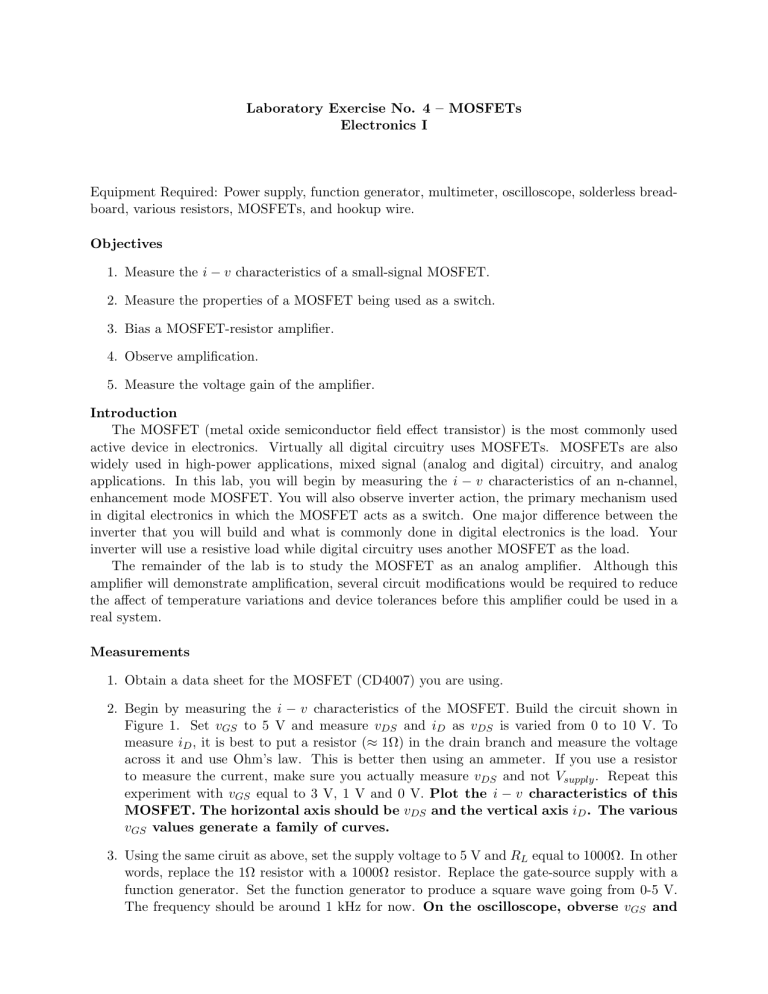
Laboratory Exercise No. 4 – MOSFETs Electronics I Equipment Required: Power supply, function generator, multimeter, oscilloscope, solderless breadboard, various resistors, MOSFETs, and hookup wire. Objectives 1. Measure the i − v characteristics of a small-signal MOSFET. 2. Measure the properties of a MOSFET being used as a switch. 3. Bias a MOSFET-resistor amplifier. 4. Observe amplification. 5. Measure the voltage gain of the amplifier. Introduction The MOSFET (metal oxide semiconductor field effect transistor) is the most commonly used active device in electronics. Virtually all digital circuitry uses MOSFETs. MOSFETs are also widely used in high-power applications, mixed signal (analog and digital) circuitry, and analog applications. In this lab, you will begin by measuring the i − v characteristics of an n-channel, enhancement mode MOSFET. You will also observe inverter action, the primary mechanism used in digital electronics in which the MOSFET acts as a switch. One major difference between the inverter that you will build and what is commonly done in digital electronics is the load. Your inverter will use a resistive load while digital circuitry uses another MOSFET as the load. The remainder of the lab is to study the MOSFET as an analog amplifier. Although this amplifier will demonstrate amplification, several circuit modifications would be required to reduce the affect of temperature variations and device tolerances before this amplifier could be used in a real system. Measurements 1. Obtain a data sheet for the MOSFET (CD4007) you are using. 2. Begin by measuring the i − v characteristics of the MOSFET. Build the circuit shown in Figure 1. Set vGS to 5 V and measure vDS and iD as vDS is varied from 0 to 10 V. To measure iD , it is best to put a resistor (≈ 1Ω) in the drain branch and measure the voltage across it and use Ohm’s law. This is better then using an ammeter. If you use a resistor to measure the current, make sure you actually measure vDS and not Vsupply . Repeat this experiment with vGS equal to 3 V, 1 V and 0 V. Plot the i − v characteristics of this MOSFET. The horizontal axis should be vDS and the vertical axis iD . The various vGS values generate a family of curves. 3. Using the same ciruit as above, set the supply voltage to 5 V and RL equal to 1000Ω. In other words, replace the 1Ω resistor with a 1000Ω resistor. Replace the gate-source supply with a function generator. Set the function generator to produce a square wave going from 0-5 V. The frequency should be around 1 kHz for now. On the oscilloscope, obverse vGS and Figure 1: A simple circuit for obtaining the i − v characteristics of a MOSFET. vDS and plot your results. Comment on the function this circuit is performing – think digital! 4. Build the circuit shown in Figure 2. Obtain a data curve of vDS vs vGS . Draw a load line on the i − v curve that you obtained above. Either the vDS vs vGS curve or the i − v curve with load line can be used to determine the value of vGS that will bias the MOSFET at a vDS of 2.5. The vDS vs vGS curve is more accurate than the i − v curve because you probably took more vGS data points than when you did the i − v. What value of vGS will bias the MOSFET such that vDS = 2.5 V? Figure 2: A simple MOSFET inverting amplifier. 5. Increase vGS by 0.1 V. Measure vDS . The small-signal voltage gain is given by ∆vDS /∆vGS . What is the small-signal voltage gain? Compare this to the slope of the vDS vs vGS curve at the bias point. Comment. 6. Decrease vGS by 0.1 V. Repeat the previous step. 2 7. The previous steps demonstrated amplification by changing the gate-to-source bias voltage. This is not a practical way to amplify a small signal. Build the following circuit (Figure 3). With the ac voltage (function generator) set to 0, adjust the dc source to meet the bias conditions used previously. Set the function generator to 1kHz and a peak voltage of 0.25 V. Make sure the output voltage is approximately sinusoidal. If it is not, reduce vin . Use the oscilloscope to obtain waveforms of vin , vGS , vDS , and vout . Comment on each waveform and the relationships between them. Calculate the voltage gain. Figure 3: A MOSFET inverting amplifier with separate signal and bias voltage supplies. 8. Increase vin until vout appears distorted. Use the oscilloscope to obtain waveforms of vin and vout under these conditions. What maximum value of vin can be amplified before noticeable distortion sets in? 9. Change the bias conditions such that vDS = 1.0 V. Adjust vin so that vout is not distorted. What is the voltage gain? Discuss this value in the context of the measurements you made in step 2. 10. Increase vin until vout appears distorted. Compare this value to the value when vDS equalled 2.5 V. Comment. 11. What value of vDS should be chosen to maximize the output voltage before distortion sets in? What is the voltage gain for this vDS ? 12. Reset the bias conditions so that vDS = 2.5 V. Vary the input frequency (up and down from 1 kHz) until the voltage gain is 0.707 times the value when f = 1 kHz. What is the range of frequencies that will be amplified by this amplifier? 3 Lab Write-Up Instead of individual, oral lab reports, this is a group, written formal (IEEE format) lab report. It should include circuit diagrams, data (generally plots, not tables), and observations. You would want to be certain to include everything that is in bold. Since we have been doing oral lab reports/demonstrations, you should have your recorded data ready to show and be able to answer questions and demonstrate building/measurements on the circuits presented in the lab. 4
